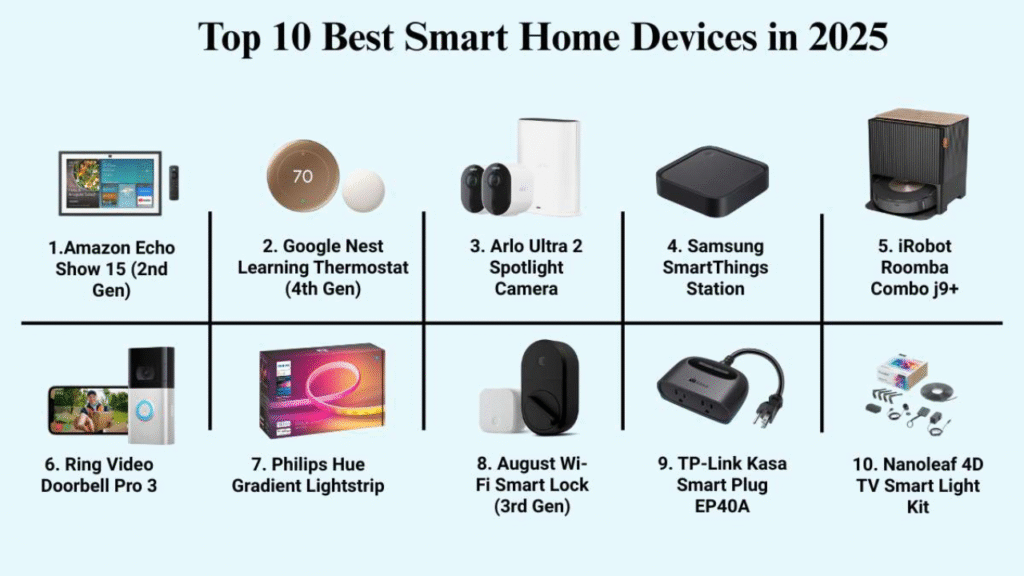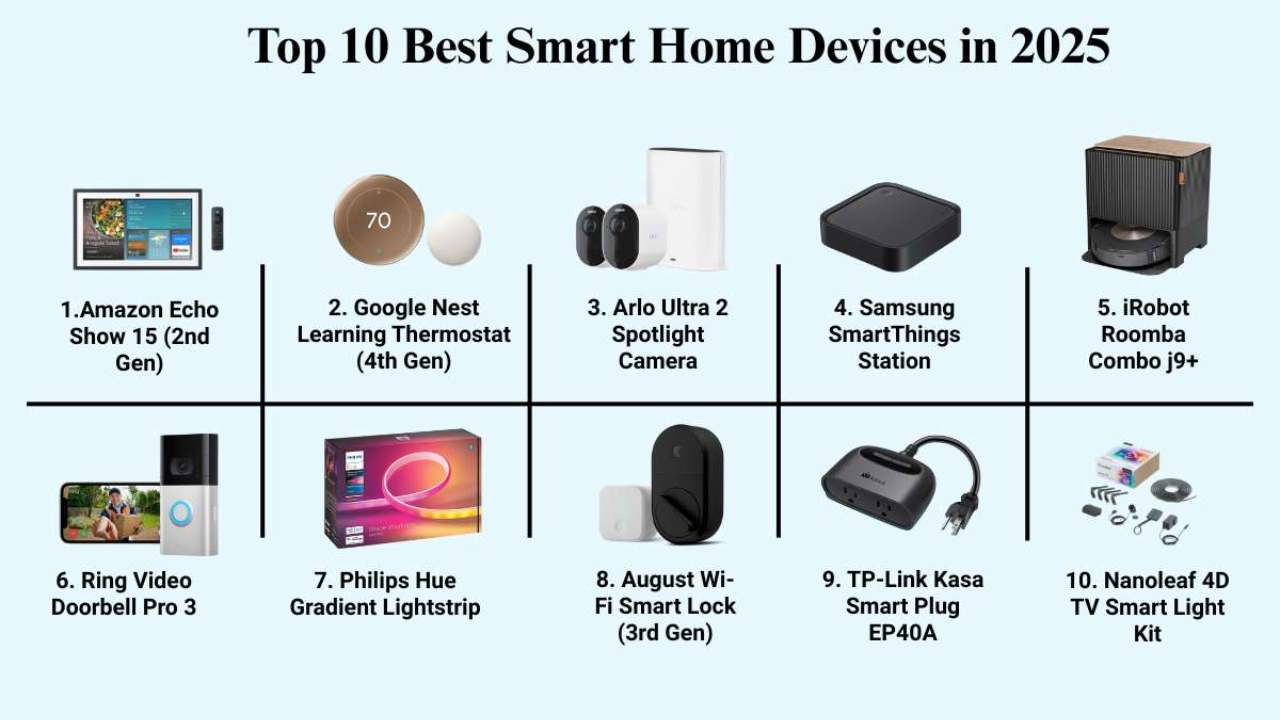
Imagine waking up to your blinds opening automatically, your coffee brewing, and your thermostat setting the perfect temperature—all without lifting a finger. This isn’t the future; it’s the new reality of smart homes powered by AI. The latest wave of smart home devices doesn’t just respond to commands—they learn from your behavior and adapt to your daily routine.
From thermostats and lights to security systems and appliances, AI-powered smart home gadgets are now becoming predictive, personalized, and proactive. These systems use machine learning, sensor data, and real-time analytics to understand your lifestyle—and make life more efficient, comfortable, and secure.
What Are Smart Home Devices That Learn?
Smart home devices that “learn” your routine are equipped with sensors, AI algorithms, and connectivity that enable them to observe your behavior, recognize patterns, and adjust their actions without needing constant user input.
They collect data like:
- When you’re home or away
- Preferred temperature and lighting settings
- Sleep and wake times
- Appliance usage patterns
- Security habits (door locking, camera monitoring)
Over time, these systems adapt to your preferences, automate repetitive tasks, and even predict what you’ll need before you ask.
Key Smart Home Devices That Learn Your Routine
- Smart Thermostats (e.g., Nest Learning Thermostat)
- Learn your temperature preferences by monitoring usage over a few days.
- Automatically adjust settings based on time of day, occupancy, and even weather forecasts.
- Smart Lights (e.g., Philips Hue, LIFX)
- Adjust brightness and color based on time, mood, or activity.
- Can learn when you typically turn on/off lights and automate accordingly.
- Smart Speakers (e.g., Amazon Echo, Google Nest Hub)
- Remember daily habits like alarms, music preferences, and routines.
- Integrate with other smart devices to initiate multi-step actions.
- Smart Security Systems (e.g., Ring, Arlo, ADT Smart Home)
- Use facial recognition and motion detection to learn who comes and goes.
- Customize alerts and automate lighting or camera recording based on typical activity patterns.
- Smart Appliances (e.g., LG ThinQ, Samsung SmartThings)
- Learn washing/drying schedules, cooking preferences, or fridge usage.
- Suggest recipes, send alerts, and adjust operations to save energy.
- Robot Vacuums (e.g., Roomba iRobot, Roborock)
- Map your house and learn high-traffic areas.
- Optimize cleaning times when no one is home and avoid obstacles automatically.
How These Devices Learn
- Sensor Data: Devices collect input from motion sensors, cameras, microphones, and usage logs.
- Machine Learning: Algorithms process this data to recognize patterns, like when you wake up or leave the house.
- Feedback Loops: Devices often let users confirm or reject suggestions, helping refine the model.
- Cloud Integration: Many devices store data in the cloud for continuous updates and remote access.
Benefits of Smart Devices That Learn
- Convenience: Automate routine tasks like adjusting temperature or turning on lights.
- Energy Efficiency: Optimize usage based on presence, reducing power consumption.
- Security: Enhance safety by recognizing unusual activity or automatically locking doors at night.
- Personalization: Tailor device behavior to individual preferences within the household.
- Time Savings: Reduce the mental load of managing your home environment manually.
Challenges and Concerns
- Privacy Risks: Learning requires data—often personal. Microphones and cameras may raise concerns.
- Connectivity Dependence: Most features require reliable Wi-Fi and cloud access.
- Security Vulnerabilities: Any smart device can be a potential point of entry for hackers.
- Cost: Premium devices with learning capabilities often come at a higher price point.
- Over-Automation: In some cases, too much automation can feel intrusive or override user intent.
Overview Table: Smart Devices That Adapt to You
| Device Type | Learning Capability | Example Use Case |
|---|---|---|
| Thermostats | Temperature preferences, schedules | Auto-adjusts heat when you leave home |
| Lights | Usage timing, brightness, color | Dims lights for bedtime without prompt |
| Speakers/Hubs | Routines, alarms, commands | Starts morning playlist and news brief |
| Security Systems | Motion patterns, user identities | Arms system automatically at night |
| Appliances | Usage frequency, energy habits | Sends alerts before food expires |
| Robot Vacuums | Room mapping, cleaning frequency | Cleans when house is empty |
Comparison Table: Traditional vs. Learning Smart Devices
| Feature | Traditional Smart Devices | Learning Smart Devices |
|---|---|---|
| Manual Programming | Required | Minimal |
| User Interaction Needed | Frequent | Rare once trained |
| Personalization | Limited | High |
| Adaptability | Static | Dynamic and evolving |
| Predictive Capabilities | None | Context-aware automation |
| Energy Optimization | Manual | Automated |
3 Best One-Line FAQs
Q1: Can smart home devices really learn my routine?
Yes, many modern devices use AI to track and adapt to your daily habits over time.
Q2: Are smart learning devices safe from hackers?
With proper security settings and regular updates, risks can be minimized—but vigilance is essential.
Q3: Do I need to control smart devices every day?
No, learning-enabled devices reduce manual input by automating your preferences and routines.
Final Thoughts
Smart home technology has moved beyond convenience—it’s becoming intuitive. Devices that learn your behavior are shaping a new kind of living environment: one that anticipates your needs, adjusts on its own, and offers a deeply personalized experience. While privacy and security must remain top priorities, the benefits of a truly intelligent home are already transforming how we live, rest, and interact with our surroundings. Your home is no longer just smart—it’s getting to know you.

